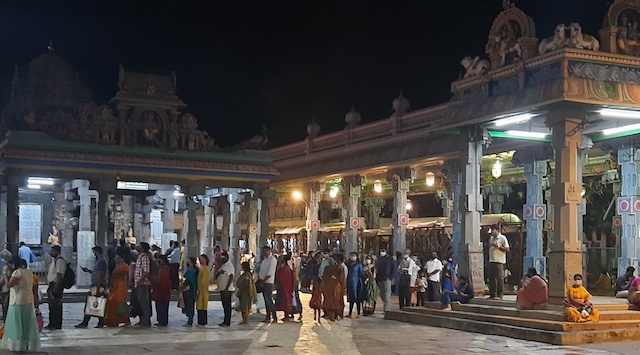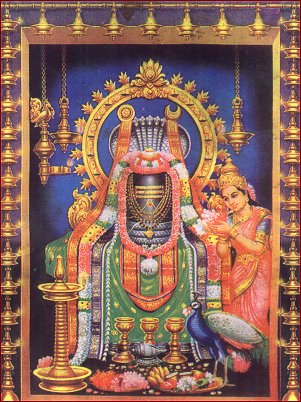About Kapaleeswarar Temple

"A Spiritual Oasis: Finding Peace at Kapaleeswarar Temple"

Here are some key facts about Kabaleeswarar Temple:
History: The exact origins of the temple are unclear, but it is believed to have been built in the 7th century by the Pallava dynasty. The temple has undergone several renovations and expansions over the centuries.
Architecture: The temple follows the traditional Dravidian style of architecture. It features a towering gopuram (entrance tower) that is intricately carved with sculptures of gods, goddesses, and mythical creatures. The inner sanctum of the temple houses the main deity, Lord Shiva, in the form of Kabaleeswarar.
Festivals: The temple is known for celebrating various festivals with great fervor. The annual Arupathimoovar Festival celebrated in March, is a significant event where the deities from various temples in the area are brought in a procession to the Kabaleeswarar Temple. Other festivals like Maha Shivaratri and Panguni Peruvizha (in the Tamil month of Panguni) are also celebrated with enthusiasm.
Legends and Mythology: The temple has several legends associated with it. According to one legend, Goddess Parvati, in the form of a peacock, performed penance at this spot. Another legend states that Lord Shiva appeared as a hunter and blessed the great sage Agastya at this location.
Cultural Significance: The Kabaleeswarar Temple is not only a religious site but also a cultural hub. It attracts devotees, tourists, and art enthusiasts from all over the world. The temple complex is known for its musical concerts, dance performances, and art exhibitions.
Connectivity: The temple is easily accessible by road and is located in the heart of Mylapore, a well-connected neighborhood in Chennai. It is approximately 10 kilometers from Chennai Central Railway Station and 15 kilometers from Chennai International Airport.
Visiting the Kabaleeswarar Temple provides an opportunity to experience the rich cultural and religious heritage of the region and witness the architectural brilliance of ancient South Indian temples.
Why is the Kapaleeswarar temple famous?

The Kapaleeswarar Temple, also known as Kapali Temple or Kapaleeswarar Temple, is famous for several reasons:
Ancient Heritage: The temple has a rich historical and cultural significance as it is believed to have been built several centuries ago. It is considered one of the oldest temples in Chennai, India, and holds great importance in the religious and architectural history of the region.
Lord Shiva as the Presiding Deity: The temple is dedicated to Lord Shiva, one of the principal deities in Hinduism. Lord Shiva is worshipped in the form of Kapaleeswarar, which means "Lord of the Skull." This form of Lord Shiva represents the destroyer aspect of the Hindu Trinity.
Dravidian Architecture: The Kapaleeswarar Temple showcases the exquisite Dravidian style of architecture, which is known for its intricate carvings, towering gopurams (entrance towers), and elaborate sculptures. The temple's architecture is a visual treat and attracts art and architecture enthusiasts.
Cultural and Religious Festivals: The temple hosts various festivals throughout the year, attracting a large number of devotees and tourists. The annual Arupathimoovar Festival celebrated in March, is particularly famous. During this festival, the deities from several neighboring temples are brought in a grand procession to the Kapaleeswarar Temple.
Mylapore Connection: The temple is located in Mylapore, a neighborhood in Chennai with a rich cultural and historical heritage. Mylapore is believed to be one of the oldest residential areas in Chennai, and the Kapaleeswarar Temple has been an integral part of its cultural fabric for centuries.
Patronage and Renovation: The temple has received patronage from various ruling dynasties and has undergone several renovations and expansions over the centuries. These renovations have helped preserve the temple's grandeur and maintain its spiritual significance.
Art and Cultural Performances: The temple complex serves as a venue for cultural events, including classical music and dance performances, during various festivals. These events attract artists and art enthusiasts, adding to the temple's cultural appeal.
The combination of its historical importance, architectural splendor, religious significance, and cultural festivities has made the Kapaleeswarar Temple famous and a significant landmark in Chennai's cultural landscape.
How many years old is Kapaleeswarar Temple?

The exact age of the Kapaleeswarar Temple in Chennai, India, is not precisely known, but it is believed to be several centuries old. The temple's origin is attributed to the Pallava dynasty, which ruled the region during the 7th century. However, the temple has undergone renovations, expansions, and reconstructions over the centuries, so the current structure may not entirely date back to its initial construction.
The temple's historical and cultural significance, as well as its architectural style, suggests that it has been a place of worship for a significant period. Its age and association with ancient dynasties contribute to its status as one of the oldest and most revered temples in Chennai.
What are the darshan timings of Kapaleeswarar Temple?

The darshan timings of Kapaleeswarar Temple in Chennai, India, are as follows:
Morning Timings:
Monday to Sunday: 5:30 AM to 12:00 PM
Evening Timings:
Monday to Sunday: 4:00 PM to 8:30 PM
It's important to note that these timings are approximate and may be subject to change during festivals and special occasions. It is advisable to check with the temple authorities or their official website for any updates or specific timings before planning your visit.
What is the history of Kapaleshwar?
Kapaleshwar, also known as Kapaleeswarar, is another name for Lord Shiva, who is worshipped in the form of Kapaleeswarar at the Kapaleeswarar Temple in Chennai, India. The history of Kapaleeswarar is intertwined with the legends and mythology associated with Lord Shiva.
According to Hindu mythology, Goddess Parvati playfully covered the eyes of Lord Shiva, plunging the entire universe into darkness. In response, Lord Shiva removed one of his own heads and used it as a begging bowl (kapala) to collect alms and restore light to the world. It is believed that the act of using his skull as a bowl gave rise to the name "Kapaleeswarar" for Lord Shiva.
The Kapaleeswarar Temple in Chennai is dedicated to this form of Lord Shiva. The temple's history dates back to the Pallava dynasty, which ruled the region during the 7th century. It is believed to have been built during the reign of the Pallava king, Rajasimha. Over the centuries, the temple has undergone renovations and expansions under the patronage of various ruling dynasties, including the Cholas, Vijayanagara Empire, and Nayakas.
The temple is considered one of the oldest and most sacred temples in Chennai. It holds immense religious and cultural significance and attracts devotees from all over the world. The legends and stories associated with Kapaleeswarar form an integral part of the temple's history and the worship of Lord Shiva in this form.
Which God is in Kapaleeswarar Temple?

The Kapaleeswarar Temple in Chennai, India, is dedicated to Lord Shiva. Lord Shiva is worshipped in the form of Kapaleeswarar at this temple. The presiding deity, Kapaleeswarar, represents the aspect of Lord Shiva as the destroyer and is revered by devotees who visit the temple to seek his blessings. The temple complex also houses shrines dedicated to Goddess Parvati, Lord Murugan (also known as Subramanya), and other deities associated with Lord Shiva.
Can we do a marriage in Kapaleeswarar Temple?
Yes, it is possible to conduct marriage ceremonies at the Kapaleeswarar Temple in Chennai, India. The temple provides facilities for conducting traditional Hindu wedding ceremonies. Many couples choose this temple for their wedding due to its historical significance and religious sanctity.
To organize a marriage ceremony at the Kapaleeswarar Temple, it is advisable to contact the temple authorities or the temple administration office in advance. They can provide you with the necessary guidelines, procedures, and any specific requirements for conducting the wedding within the temple premises. It is important to note that certain rules and regulations may need to be followed, such as obtaining prior permission, adhering to temple customs, and possibly making a reservation.
Additionally, it is recommended to consult with a priest or wedding planner who has experience with conducting ceremonies at the temple. They can assist in ensuring that all the rituals and customs are performed correctly and in accordance with the temple traditions.
Please note that the specific details and procedures may vary, so it is important to reach out to the temple authorities directly for the most accurate and up-to-date information regarding conducting a marriage ceremony at the Kapaleeswarar Temple.
Where is the original Kapaleeswarar Temple?

The original Kapaleeswarar Temple, also known as the Arulmigu Kapaleeswarar Temple, is located in Mylapore, Chennai, India. Mylapore is an ancient neighborhood in Chennai, and the temple is situated in the heart of this area. The temple complex stands as a significant religious and cultural landmark in Chennai and is dedicated to Lord Shiva in the form of Kapaleeswarar.
The Kapaleeswarar Temple in Mylapore is considered the original and primary temple dedicated to Kapaleeswarar. It is a revered site of worship and attracts devotees from all over the world. The temple has a long history dating back centuries and has undergone renovations and reconstructions over time to preserve its architectural beauty and religious sanctity.
Which direction is Kapaleeswarar temple facing?
The Kapaleeswarar Temple in Chennai, India, is facing east. The main entrance of the temple, known as the Rajagopuram, is situated on the eastern side. This is the direction towards which devotees face when entering the temple premises. The east-facing entrance is a common feature in many Hindu temples, as it is considered auspicious and symbolizes the rising sun and the light of knowledge.
What is special in Kapaleeswarar Temple?

The Kapaleeswarar Temple in Chennai, India, is known for several unique and special aspects. Here are some of them:
Architecture: The temple showcases the Dravidian style of architecture, renowned for its intricately carved gopurams (entrance towers), mandapams (halls), and sculptures. The temple's architectural grandeur and intricate detailing make it a visually stunning and significant cultural monument.
Gopurams: The Rajagopuram, the main entrance tower, is an iconic feature of the Kapaleeswarar Temple. It stands tall and is adorned with elaborate carvings and sculptures depicting various gods, goddesses, and mythological scenes.
Sanctum Sanctorum: The inner sanctum of the temple houses the main deity, Lord Shiva, in the form of Kapaleeswarar. The sanctum is considered sacred, and devotees offer prayers and seek blessings from the deity.
Kanaka Sabha: The Kanaka Sabha is a unique hall within the temple complex that features gold-plated wooden sculptures. It is a significant attraction and adds to the temple's architectural and artistic value.
Tank: The temple has a sacred tank, known as the Kapaleeswarar Temple Tank or Sivagangai, located adjacent to it. Devotees believe that taking a dip in this tank and offering prayers can cleanse them of their sins and bring them spiritual merit.
Festivals: The temple celebrates various festivals with great enthusiasm. The annual Arupathimoovar Festival, where deities from neighboring temples are brought in a grand procession, is a major highlight. Other festivals like Maha Shivaratri and Panguni Peruvizha are also celebrated with devotion and grandeur.
Cultural Significance: The Kapaleeswarar Temple is not only a religious site but also a cultural hub. It hosts classical music and dance performances, art exhibitions, and cultural events, attracting artists and art enthusiasts.
The combination of its architectural beauty, religious significance, historical importance, and cultural vibrancy makes the Kapaleeswarar Temple a special and revered place for devotees and visitors alike.


